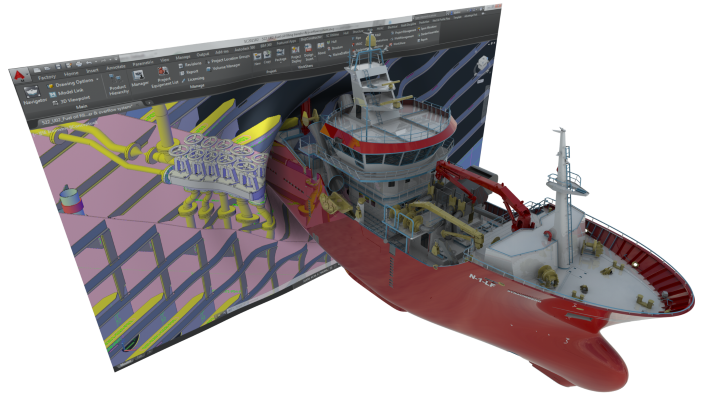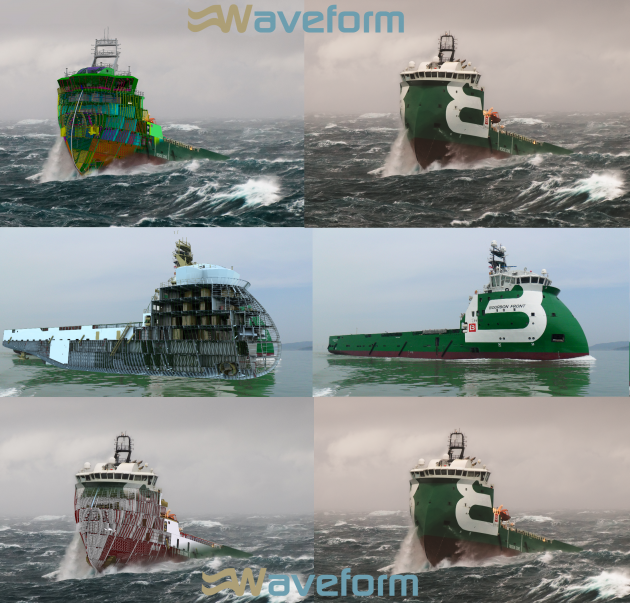
We have heard the term “digital twin” being used more frequently throughout the literature we read or even at conferences we attend. I have also written several blog posts about the benefits of the digital twin as well as Achieving the Digital Twin. However, after receiving several inquiries about, “what is a digital twin?” I realized that I have not described the concept. Even though there are some really good resources that talk about the digital twin, I thought I would provide a very high-level view from a shipbuilding perspective. I also thought I would “simplify” it by providing an example which will hopefully resonate with you.

Digital Shipbuilding
Get a first-hand experience of what the design, build, and maintenance phases are like in an increasingly digital shipyard.
Experience nowVery High-Level View
The concept of digital twin is not new. Its origins can be tracked back over a decade ago using different names which were not as catchy as the digital twin. The idea of the digital twin is that for each physical product such as an individual physical ship there is one and only one exact digital replica. The evolution of the physical ship throughout its lifecycle will mirror the digital version. This means if any changes happen to the physical asset, the digital version will also get updated.
This does mean for every single ship we produce there will be one and only one digital twin. Even each sister ship will have their own digital twin representation because we all know there are no two ships that are the same, ever.

The digital twin concept is similar to the shipbuilding term “As-Built” but goes a lot further throughout the entire lifecycle of the ship. As with the As-built terminology, all the geometric data and the attributes originating from the engineering CAD tool are included. However, much more data would be required to be a “true” digital twin. This will include linking to items such as:
- Class approvals
- Requirements of the ship linked to the items (parts, assemblies, etc.) that satisfy them
- Change Requests of clients and linked to items which are satisfy change request
- Vendor Furnished Information (VFI) linked to each instance of the item (engine, valve, pump, etc.)
- Production processes such as welding, assembly sequencing, workstation/workcenter
- Simulations and calculations
- Paint information
As well, information after delivery will be associated with the digital twin such as:
- Service records of replaced items for maintenance, warranty, etc. with information being associated to items
- Actual sensor data of items which record data
- Repair and retrofit changes
- Class surveys
- Removal of fouling documentation
The digital twin can add value throughout the lifecycle (conception, design, engineering, construction, procurement, testing, delivery, operations, etc.) of the ship; however, you will hear a lot about how it can significantly improve operations of a ship in the shipping industry. This is related to a parallel technology IoT which allows us to access real-time data from the sensors on the ship to make better informed decisions. There is no doubt that a digital twin can improve operations for the owner/operator; however, there is just as much benefit which can be leveraged prior to all stages before delivery. Not to mention that it will be the shipbuilders and designers which will have to build the digital twin for the owners/operators to leverage as I mentioned in my blog post Future of Shipbuilding: Detail Design and Production Planning (Part 2)
Digital Twin Example
I hope the information above provided a high-level overview of the digital twin. To aid in my attempt to explain what the digital twin is I thought I would also provide a simple example of a digital twin. The example is the same example I used in my blog post Business vs. Digital Transformation which is Google Maps.
Think of the roads and buildings in your city as your product (ship) and the information stored in Google Maps (street names, office buildings, restaurants, speed limits, parks, gas stations, links between information, etc.) as the single digital representation or the digital twin.
When there is a new road or building added or traffic patterns change, then the information in Google Maps is updated to reflect the real physical object (the roads & buildings).
With the digital twin you can better interact and consume information from your product with accurate real-time data. For example, you can search a location and be provided with its location on the map. Taking it one step further, people’s phones with GPS enabled are in essence an IoT device allowing you to get real-time information such as traffic congestion. This now allows the digital twin to not only show you the location you entered but also the fastest real-time route considering all traffic at the time of the search. The possibilities are endless when you have the digital twin.
Before you Criticize
I know the roads are not Google maps products, road/building information does not update all the time, etc. but hopefully you can get around those inconsistencies to understand the essence of what I am trying to convey.
A Good Enough Digital Twin
There is a lot of discussion about how complete a digital twin needs to be. Does it need to contain all possible information to be considered a twin?
In my opinion, a digital twin ideally would have all information but practically it will only have a subset of information. You do not want to waste time collecting information of anything that you will not action in the future. Also, your first iterations of your digital twin will only have a small subset of the information you want/need. This is 100% fine as the only way to get the digital twin you deserve is if you take small, value-adding steps.
Google maps is probably closer to a digital twin than we will get in manufacturing any time soon but it is also not perfect. For example, it is not always updated when a new road is complete. Some information is incorrect as it does rely on non-paid community members to update information. Also, there are locations that are off a major road like mall parking lots which do not work as well as on streets.
So even though Google Maps is not a 100% complete representation of its physical product, it is still a good enough digital twin.
Multiple Digital Twins?
For most practical purposes I believe we will have an issue with creating and maintaining one all-encompassing digital twin of our asset. As with Google Maps which has a lot of great information, it does not have all the information for a city planner. They will need additional information such as locations of water pipes, electrical grid information and various other types on important information.
This is where I believe we will have several platforms (software tools) which will contain certain types of information of the digital twin. Again, it would be nice to have just one, but there does not look like there is any possible platform/solution which will be able to hold all information despite what many software vendors say.
This is where you will see (hopefully) many software solutions/platforms that support a specific portion of the digital twin and link together to build a more comprehensive and unified view of a digital twin. If you refer to the Google Maps example, it is exactly this strategy that they used. The Google Maps platform is used for several other services which provide more valuable insight from calling a cab, getting restaurant reviews, seeing nearby friends, etc.
However, as mentioned before, you will see companies starting to leverage the digital twin with a single platform as this is the natural first step and will still add tremendous value for their business.
Closing Remarks
The digital twin concept has been around for over a decade; however, it seems to be getting a fair share of the limelight, and rightfully so. The benefits of implementing the digital twin can be huge in the short term and in the long term will be a requirement of doing business in manufacturing business such as shipbuilding.
A digital twin (digital ship) is “simply” a digital replica of the physical asset. It in theory includes all information about the ship; however, in practice in the near future will only contain a subset of the information. There is one and only one digital twin for every single ship, no more, no less. The digital twin will evolve with the physical ship and should mirror each other at all times.
IoT in many industries is what is driving the adoption of the digital ship; however, there is a lot of benefit that can be realized even without IoT.
There is no single platform which can holistically hold the entire digital twin. This is where you will see strategies similar to the ones used by Google Maps (and SSI?). Effective strategies involve providing a platform that others can build on to fill out the digital twin.
I leave you with this quote:
Digital twins are becoming a business imperative, covering the entire lifecycle of an asset or process and forming the foundation for connected products and services. Companies that fail to respond will be left behind.
-Thomas Kaiser, SAP Senior Vice President

Post Comments
Have you seen much traction on the question you asked a couple of years ago, on ‘As Built’?
Good question @antonykrokowski:disqus
Traction on the As-Built has been very very slow to almost not at all. Even though it is a great idea I do not think we as an industry was ready to leverage it enough to tilt the cost vs benefit in our favour.
Even though the digital twin is even “more” complex than the As-Built, I do believe the next few years will get more traction than the last decade. The main reason is the benefit is now being shared not only by the shipbuilders but by the owner/operators. This higher benefit will mean the additional investment for creating and updating the digital twin will be worth it. However, I still see a lot of challenges ahead which I will discuss in a future post.
I see a lot of data being shared by “parallel” digital twin on different platforms, data that is useful to all and should also exist as a single instance. Using the multi-platform paradigm, such data could be considered yet another digital twin, albeit not one of immediate use to anybody by itself. For example, a manhole cover cracks, requiring:
– blocking the road for repairs (affects google maps)
– managing the repair (affecting the Municipality maintenance office)
– inspection of the underlying utility to check for damage during the repairs period (affecting utility management)
– etc.
Thank you Denis for another thought-provoking write-up, i find many similarities with “my version” of “holistic” workflows and will freely take inspiration from your work (again). Somewhat surprisingly, resistance to the holistic approach (in my case) comes from software writers, who fail to se the big picture in which the customer lives and remain totally app-centric (each in their own app, that is :-))